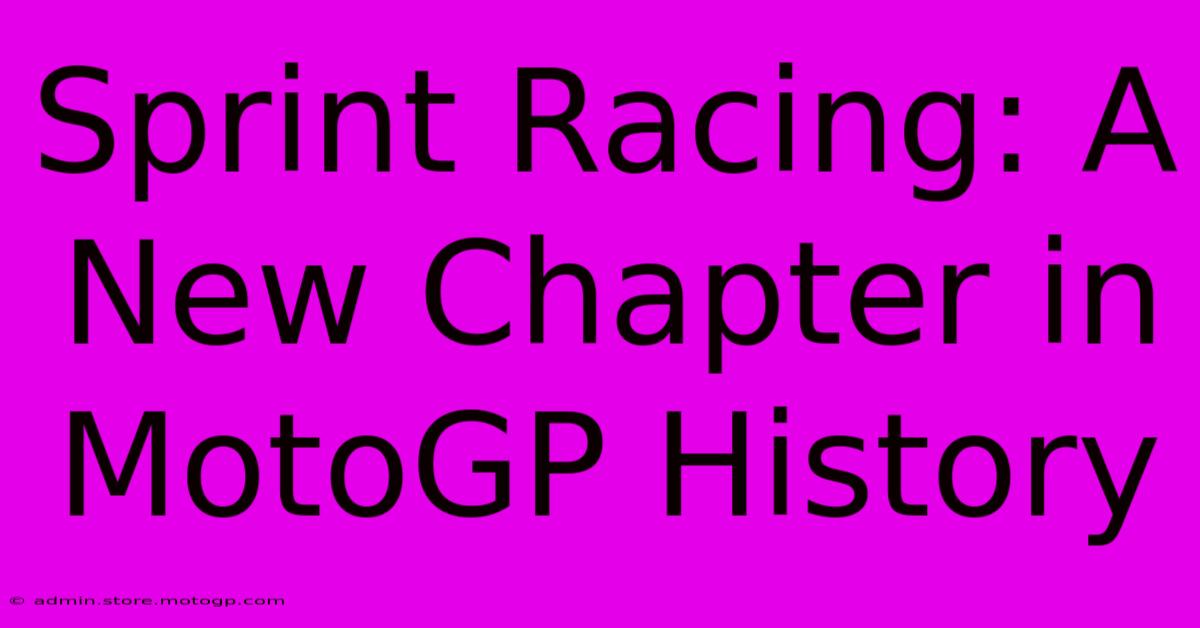Sprint Racing: A New Chapter In MotoGP History

Table of Contents
Sprint Racing: A New Chapter in MotoGP History
The roar of the engines, the smell of burning rubber, the heart-stopping overtakes – MotoGP has always been a spectacle. But 2023 marked a significant shift in the sport's dynamic with the introduction of Sprint Races. This new format has injected a thrilling dose of unpredictability, altering team strategies, and sparking fervent debate amongst fans and pundits alike. This article delves into the impact of Sprint Races, examining their benefits and drawbacks, and exploring their potential to reshape the future of MotoGP.
What are Sprint Races?
Introduced in 2023, Sprint Races are shorter races held on Saturday, comprising roughly one-third of the distance of a Grand Prix. Points are awarded to the top nine finishers (12-9-7-6-5-4-3-2-1), adding another layer of competition to the weekend. These races are not simply warm-ups; they're fully fledged contests, impacting grid positions for Sunday's main Grand Prix and providing valuable championship points. This means riders have to push hard from the very beginning, leading to intense battles and increased risk-taking.
How Sprint Races Impact the Weekend
The addition of Sprint Races has dramatically changed the MotoGP weekend schedule. Teams now need to optimize their strategies across three intense sessions: Free Practice, qualifying, and the Sprint Race itself. This compressed timeframe necessitates meticulous planning and efficient resource allocation. The consequences of a poor Sprint Race performance ripple through to Sunday, potentially impacting tire choice, race strategy, and even rider confidence.
The Pros and Cons of Sprint Racing
The introduction of Sprint Races has been met with mixed reactions. While some celebrate the increased excitement and unpredictable nature of the format, others express concerns about rider safety and the potential for increased fatigue.
Arguments in Favor:
- Increased Excitement and Action: The shorter format encourages more aggressive racing, with riders taking greater risks early on. This translates to more thrilling battles and overtaking opportunities.
- Additional Championship Points: The points awarded in Sprint Races add another layer of intrigue to the championship battle, making every session crucial.
- More Opportunities for Points: Even riders starting further down the grid have a chance to score valuable points, which can significantly impact their championship standings.
- Enhanced Fan Engagement: The added racing action delivers a more engaging viewing experience for fans, keeping them captivated throughout the weekend.
Arguments Against:
- Increased Risk of Injury: The high-intensity racing, particularly with tire degradation, increases the risk of crashes and rider injuries.
- Rider Fatigue: The demanding schedule could lead to rider fatigue, potentially impacting performance and increasing the risk of errors in the main Grand Prix.
- Cost Implications for Teams: The added pressure necessitates more resources for teams in terms of tire allocation, personnel, and equipment.
- Impact on Qualifying: Some argue the Sprint Race minimizes the importance of traditional qualifying, altering its significance in determining grid positions.
The Future of Sprint Racing in MotoGP
The long-term effects of Sprint Races on MotoGP are still unfolding. The initial seasons have been a fascinating experiment, offering valuable data for Dorna Sports to analyze and refine the format. Adjustments to the points system, race distances, and even the scheduling could be on the horizon, reflecting feedback from riders, teams, and fans alike. The future of Sprint Racing will depend heavily on the balance between maintaining excitement and mitigating risks.
Conclusion
Sprint Races represent a bold evolution in MotoGP, injecting a shot of adrenaline into the sport's DNA. While challenges remain concerning rider safety and team resources, the heightened excitement and enhanced championship dynamics are undeniable. As the sport continues to evolve, the success of Sprint Races will be measured not only by their entertainment value but also by their long-term impact on the overall health and competitiveness of MotoGP. The next chapter in MotoGP's history is being written, and the Sprint Race is undoubtedly a key element in its narrative.

Thank you for visiting our website wich cover about Sprint Racing: A New Chapter In MotoGP History. We hope the information provided has been useful to you. Feel free to contact us if you have any questions or need further assistance. See you next time and dont miss to bookmark.
Featured Posts
-
Get Up Close And Personal With Moto Gp On Tnt Sports
Feb 20, 2025
-
Cota Parking Park Closer Faster With This Map
Feb 20, 2025
-
Moto Gp Qualifying How The Grid Takes Shape
Feb 20, 2025
-
Moto Gps Most Competitive Seasons Battles For Glory
Feb 20, 2025
-
Cota Track Day Make Your Mark On The Track
Feb 20, 2025
